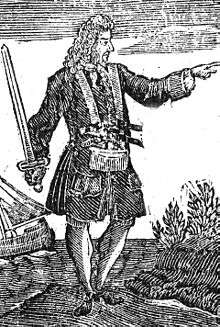Charles Vane
| Charles Vane | |
|---|---|
 An early-18th-century engraving of Charles Vane | |
| Born | c. 1680 |
| Died |
March 29, 1721 (aged 40) Port Royal, Jamaica |
| Type | Pirate |
| Allegiance | None |
| Years active | 1716–1719 |
| Rank | Captain |
| Base of operations | West Indies |
| Commands |
Lark Ranger (six-gun sloop) Ranger (12-gun brigantine) |
Charles Vane (c.1680 – March 29, 1721) was an English pirate who preyed upon English and French shipping. His pirate career lasted from 1716 to 1719. His flagship was a brigantine named the Ranger.
Vane was among the pirate captains who operated out of the notorious base at New Providence in the Bahamas known as the "Pirates' republic", after the British abandoned the colony during the War of the Spanish Succession. He was captured in 1721 after a relatively long and violent career in piracy, and was executed by hanging at Gallows Point, Port Royal, Jamaica.[1]
Pirate career
|
Investigation of potential copyright issue | |
| If you have just labeled this page as a potential copyright issue, please follow the instructions for filing at the bottom of the box. | |
 The previous content of this page or section has been identified as posing a potential copyright issue, as a copy or modification of the text from the source(s) below, and is now listed on Wikipedia:Copyright problems (listing):
Unless the copyright status of the text on this page is clarified, the problematic text or the entire page may be deleted one week after the time of its listing. | |
| Can you help resolve this issue?
If you hold the copyright to this text, you can license it in a manner that allows its use on Wikipedia. Click "Show" to see how.
To demonstrate that this text is in the public domain, or is already under a license suitable for Wikipedia, click "Show".
Explain this on this article's discussion page, with reference to evidence. Wikipedia:Public domain and Wikipedia:Compatibly licensed may assist in determining the status. Otherwise, you may write a new article without copyright-infringing material. Click "Show" to read where and how. Your rewrite should be placed on this page, where it will be available for an administrator or clerk to review it at the end of the listing period. Follow this link to create the temporary subpage.
| |
About importing text to Wikipedia
|
Instructions for filing
If you have tagged the article for investigation, please complete the following steps:
|
Capture and execution
Vane's final blow came after his ship was wrecked in a storm in February 1719, separating him from his consort Robert Deal. Vane was one of the few survivors, washed up on an uninhabited island in the Bay of Honduras. Eventually, a ship arrived but, unfortunately for Vane, it was commanded by his old acquaintance and former buccaneer Captain Holford. Holford refused to rescue Vane from the island, stating:
Charles, I shan't trust you aboard my ship, unless I carry you a prisoner; for I shall have you plotting with my men, knock me on the head and run away with my ship a pirating.[5]
Before departing, Holford stated that he would be back on the island in a month, and threatened that if he found Vane still there, he would take him back to Jamaica and hang him. Another ship soon arrived and none of the crew recognized Vane, so he was allowed on board. Unluckily, Captain Holford's ship met with this ship at sea. The captain of Vane's ship was a friend of Holford's, and he invited Holford to dine with him. While there, Holford saw Vane working aboard and informed the captain who Vane truly was. The captain immediately relinquished Vane to Captain Holford, who locked him in his hold and turned him over to the authorities in Jamaica.
It is unclear why Vane was imprisoned for over a year before the trial. He may have been marooned longer than the few weeks recorded, or there may have been distant witnesses to gather once he was captured. Most likely, his reputation had earned the disdain of pirates, royal mariners, and the public at large, and they wanted him to rot in gaol before being executed. At his trial, numerous witnesses testified against him from merchant vessels captured by Vane, as did Vincent Pearse, Captain of HMS Phoenix, who related how Vane had made a mockery of the King's pardon. When it was Vane's turn to present his defence, he called no witnesses and asked no questions. He was found guilty on March 22, 1721 and sentenced to death. On March 29, 1721, Vane was hanged at Gallows Point in Port Royal.[6] He died without expressing remorse for his crimes. After death, his body was hung from a gibbet on Gun Cay, at the mouth of harbor at Port Royal, as a warning against piracy.
In popular culture
- Jack Galloway played Vane in Blackbeard: Terror at Sea.
- Charles Vane is fictionalized in the Starz 2014–16 TV series Black Sails, portrayed by Zach McGowan.
- He appears as a non-player character in the 2013 video game Assassin's Creed IV: Black Flag, voiced by Ralph Ineson.
References
- 1 2 Woodard 2007, pp. 234–240.
- ↑ Woodard 2007.
- ↑ "Charles Vane, Pirate Charles Vane, Captain Charles Vane". ThePiratesRealm.com. Retrieved 2012-03-25.
- ↑ "Pirate Encyclopedia: Charles Vane". AgeOfPirates.com. Retrieved 2012-03-25.
- 1 2 "Cross and Cutlass: Charles Vane, Charles Towne Pirate". CrossAndCutlass.blogspot.com. 2009-02-13. Retrieved 2012-03-25.
- ↑ "When did Charles Vane die?". RepublicOfPirates.net. 2008-10-18. Retrieved 2012-03-25.
- Menefee, S.P. "Vane, Charles," in Oxford Dictionary of National Biography, vol. 56 (2004): pp. 94–95.
- Pickering, David. Pirates. CollinsGem. HarperCollins Publishers, New York, NY. (2006):p-75.
- Woodard, Colin (2007). The Republic of Pirates. New York, NY.: Harcourt, Inc. ISBN 978-0-15-603462-3.